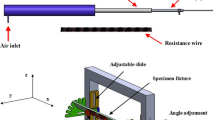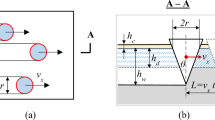Abstract
In processes using slurry as the working fluid, wear due to solid particles impinging on elements of the process units is a serious reliability issue. This study considers modeling wear damage in flotation cells, which are widely used in mineral processing. Flotation cells are typically cylindrical vessels where an impeller is used to agitate the fluid, enabling the liberation of the minerals from the slurry. Some solids, particularly those entrained in the impeller stream, can impact on the wall of the cell, leading to material loss and eventually to loss of structural integrity. The problem of predicting the remaining life of the unit due to erosion requires understanding of various sub-processes: flow modeling, particle–fluid interaction, energy interactions at the surface, and the mechanism of erosion itself. In this study, empirically developed equations for the flow field of cylindrical mixing vessel with a Rushton turbine are used in formulating a model relating and the damage accumulation rate to a simple set of measurable variables. To validate a model, a PIV technique was used to measure velocities in the flow field and near the wall on a physical model of the cell with transparent walls and particles that match the refractive index of the fluid. An Eulerian–Langrangian approach has been used to determine the particle trajectories and the effect of a squeeze film is incorporated into the model to modify the velocity distribution of particles prior to impacts. An analytical model based on equations of impulse and momentum for a particle of any shape striking a flat massive surface has been used to describe the energy lost at the walls. Finally, a damage model is developed that takes into account impact velocity, attack angle, properties of the impinging particles and the surface. This model is verified against a second physical model that measures material loss rate at different locations within the cell.













Similar content being viewed by others
References
Gillies, R.G., Shook, C.A.: Modeling high concentration settling slurry flows. Can. J. Chem. Eng. 78, 709–716 (2000)
Gupta, R., Singh, S.N., Seshadri, V.: Study on the uneven wear rate in a slurry pipeline. Bulk Solids Handl. 15(4), 603–607 (1995)
Salama, M.M.: An alternative to API 14E erosional velocity limits for sand-laden fluids. J. Energy Resour. Technol. Trans. ASME 122(2), 71–77 (2000)
Wood, R.J.K., Jones, T.F., Ganeshalingam, J., Miles, N.J.: Comparison of predicted and experimental erosion estimates in slurry ducts. Wear 256(9–10), 937–947 (2004)
Schaan, J., Cook, N., Sanders, R.S.: On-line wear measurements for commercial-scale, coarse-particle slurry pipelines. In: 17th International Conference on the Hydraulic Transport of Solids. The South African Institute of Mining and Metallurgy and the BHR Group (2007)
Roco, M.C., Addie, G.R.: Erosion wear in slurry pumps and pipes. Powder Technol. 50, 35 (1987)
Wilson, K.C., Addie, G.R., Sellgren, A., Clift, R.: Slurry transport using centrifugal pumps, 3rd edn. Springer, New York (2006)
Platzer, B., Noll, G.: Modelling of the local distributions of velocity components and turbulence parameters in agitated vessels—method and results. Chem. Eng. Process. 23, 13–31 (1988)
Niu, Y.Y.: Evaluation of erosion in a two-way coupled fluid–particle system. Int. J. Numer. Methods Fluids 36(6), 711–742 (2001)
Humphrey, J.A.C.: Fundamentals of fluid motion in erosion by solid particle impact. Int. J. Heat Fluid Flow 11(3), 170–195 (1990)
Boothroyd, R.G.: Flowing Gas-Solids Suspensions. Chapman and Hall, London (1971)
Clark, H.M., Burmeister, L.C.: The influence of squeeze film on particle impact velocities in erosion. Int. J. Impact Eng. 12(3), 415–426 (1992)
Brach, R.M.: Impact dynamics with applications to solid particle erosion. Int. J. Impact Eng. 7, 37–53 (1988)
Sundararajan, G.: A comprehensive model for the solid particle erosion of ductile materials. Wear 149, 111–127 (1991)
Finnie, I.: Erosion of surfaces by solid particles. Wear 3, 87 (1960)
Bitter, J.P.A.: A study of erosion phenomena part I. Wear 6, 5 (1963)
Bitter, J.P.A.: A study of erosion phenomena part II. Wear 6, 169 (1963)
Meng, H.C., Ludema, K.C.: Wear models and predictive equations: their form and content 181–183, 443–457 (1995)
Oka, Y.I., Yoshida, T.: Practical estimation of erosion damage caused by solid particle impact. Part 2. Mechanical properties of material directly associated with erosion damage. Wear 259, 102–109 (2005)
Oka, Y.I., Okamura, K., Yoshida, T.: Practical estimation of erosion damage caused by solid particle impact. Part 1: effects of impact parameters on a predictive equation. Wear 259, 95–101 (2005)
Paul, E.L., Atiemo-Obeng, V.A., Kresta, S.M.: Handbook of Industrial Mixing. Wiley-Interscience, Hoboken (2004)
Wu, J., Nguyen, B., Graham, L., Zhu, Y., Kilpatrick, T., Davis, J.: Minimizing impeller slurry wear through multilayer paint modelling. Can. J. Chem. Eng. 83(5), 835–842 (2005)
Acknowledgments
Funding support is acknowledged from the Natural Sciences and Engineering Research Council, Syncrude Canada Ltd., and the University of Alberta.
Author information
Authors and Affiliations
Corresponding author
Rights and permissions
About this article
Cite this article
Lipsett, M.G., Bhushan, V. Modeling Erosion Wear Rates in Slurry Flotation Cells. J Fail. Anal. and Preven. 12, 51–65 (2012). https://doi.org/10.1007/s11668-011-9496-2
Received:
Published:
Issue Date:
DOI: https://doi.org/10.1007/s11668-011-9496-2




